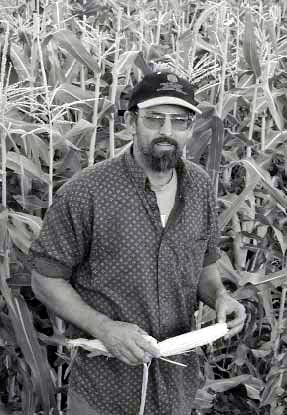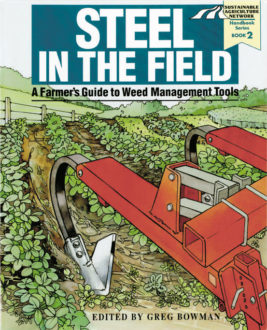
Agronomic Row Crops: The Farmers
More Weed Control With Fewer Passes
Peter Kenagy
Albany, Oregon
- 300 acres
- wheat, grass seed, sweet corn, snap beans
- diverse cover crops
Weed management highlights
Strategies: strip tillage into herbicide- and winter-killed covers... banded herbicides... field borders in mowed sod crops... prevention of off-site introduction of weed seeds
Tools: Maximum-residue cultivator... rotary hoe... front-mount conventional cultivator.. rotary tiller
Cover crops on Peter Kenagy's farm in Oregon's Willamette Valley may be wavy, green and 6 feet tall, or bushy, scarlet and knee high. All serve to improve soil quality, prevent erosion and help him manage weeds in row crops, with the help of strip-till planting and a maximum-residue cultivator.
He manages the species, germination date and method of killing of each cover crop so that it contributes optimum benefits at crucial points throughout his cash-crop season. Species that regrow each spring after the region's mild winters increase their biomass contribution and outcompete early weeds.
Warm-season Sudangrass, by contrast, follows his earliest commercial snap bean crop. The tall, thin stalks smother summer weeds with their profuse vegetation that dies with the first frost. He has to plant Sudangrass for cover-crop use after mid-July to avoid seed set but before August 10 to achieve sufficient growth before frost.
Kenagy's succession of at least four sweet corn plantings starts in the dead Sudangrass, where he applies Roundup to control bothersome winter annuals. Roundup is a non-selective, non-residual systemic herbicide. He plans a 10- to 30-day window before planting. During that time, weed biomass and an apparent post Roundup flush of soil microbial activity die down, clearing the way for better corn seedling development. His spring barley germination suffered in '96 within areas where he had applied Roundup to suppress ryegrass the same day that he planted.
Kenagy developed pieces of his sustainable low-spray, strip-till planting system for sweet corn in '95. Testing cover-crop species and ways to kill them, he successfully
- No-till seeded the corn in April into volunteer wheat killed by herbicides 2 weeks earlier growing in unmowed wheat stubble.
- Strip-tilled the corn into a rape/oats mix that had been grazed by sheep the previous fall then killed with herbicides in March when it was 18 to 24 inches tall. He tries to terminate the cover crop before it grows too much biomass to accommodate the strip tillage.
- Herbicide-killed annual ryegrass at the end of April with Roundup.
- Flail-mowed crimson clover at 18 inches tall in early June.
- Let sheep graze triticale (a wheat-rye cross) in April and early May, then let leaves regrow enough to make herbicide effective in late May. In '96, a dry spell just before planting prompted him to also flail mow the stemmy stubble to create a moisture-retaining mulch.
All told, Kenagy planted 100 acres of sweet corn in '96 by rotary tilling 6-inch strips into cover crops of the rape/oats mixture, crimson clover and winter-killed Sudangrass. Weather problems caused the clover to mature past its 'easy to handle' time. He had to tediously flail-mow it at about 2 mph after it had bloomed and become quite fibrous, disk it twice with his 12-foot offset disk, then power-harrow it to break up clumps of biomass. His corn did well, but he admitted the delayed start increased labor, fuel and machine use to uncomfortable levels.
The rotary-tilling cultivator he converted for strip-till planting works just well enough that he and other growers in his area who are interested in pursuing the practice agree that they need to find a more versatile and sophisticated strip-till planting tool.
The Yetter Residue-Manager wheels on his John Deere 7000 planter eliminate surface irregularities that could create uneven planting depth. Well-aerated and elevated about 2 inches higher than the undisturbed row middles, the tilled strip warms faster to speed crop development, Kenagy reports. He sees 85 to 90 percent germination in the tilled strips, compared with a 50 percent rate when he no-tills the same non-vigorous varieties of sweet corn that he grows on contract for processing.
Kenagy applies a 10-inch band of a grass and broadleaf herbicide mix over the rows at planting to suppress early weeds. He evaluates each field's weed pressure to put on just enough herbicide to hold back in-row competitors until he cultivates. He delays the first pass of his maximum-residue cultivator until weeds eventually pop through the cover crop residue between the rows. While the specialty corn usually demands a weed-control pass at about its 5-inch stage under conventional tillage, he doesn't cultivate the strip-tilled corn until it is about 10 to 14 inches tall. He says not disturbing the soil or residue in the row middles slows weed seed germination.
'I used to cultivate two or more passes in sweet corn because weeds were a problem earlier,' he explains. He gets by now with only one - sometimes two - trips with his Buffalo 6600.
For Kenagy, the 20-inch, point-and-share sweeps on the heavy-duty tool take out redroot pigweed and lambsquarters of about any size, but he has trouble with purslane plants re-rooting. He sets disk hillers 3.5 to 4 inches from the row, throwing soil to the row middles. He responds to variable conditions at second pass by just moving the hillers out slightly, possibly turning them around to lightly cover in-row weeds, or removing them if weed pressure is negligible.
He adjusts the cultivator to minimize ridging by the sweeps. Even a slight crest interferes with the ground-level swather needed to harvest the following ryegrass seed crop. The moderate corn residue is not a problem at ryegrass planting or harvest, he reports.
Kenagy has full view of his low-tech, front-mounted cultivator from the seat of his Farmall M. He uses the narrow-front 'tricycle' tractor rig for precision cultivating his string beans in clean-tillage situations. They usually follow a wheat or grass-seed crop that is disked (unless heavy residue requires plowing). He then uses a spike-tooth harrow or a Lely Roterra, a PTO-powered harrow with horizontally spinning vertical club tines.
His traditional multiple-toolbar cultivator has horizontal gang mounting bars suspended from its main 10-foot toolbar. The gang bars give him infinite tool spacing adjustment. Closest to the row, he runs 8-inch disk hillers that move little soil at his low-speed (3 to 4 mph) operation but push out weeds within 2.5 inches of the row. He sets 14-inch, L shaped vegetable knives within 4 inches of the row, with the sharpened blade edges trailing out and backward toward the row middles.
'The knife's vertical shank curves inward at the base, putting the inside blade edge closer to the plant than the top of the shank,' Kenagy explains. 'This is gentle on the crop, slices out small weeds and doesn't throw around any dirt.' Two 10-inch goosefoot sweeps on straight, rigid shanks take out weeds between the 30-inch rows, while rear-mounted S-tines loosen the tractor wheel tracks.
Kenagy needs a flat inter-row area for efficient harvest of low-hanging snap beans. To level the soil, he pulls mounted gangs of old cast-iron roller wheels between the rows at last cultivation. Because he harvests and replants covers within a month of the treatment, weeds don't have time to set seed or reduce bean yield.
He runs the front-mounted unit without shields. But with his single-sweep, maximum- residue cultivator - operated at 5 mph - he needs to protect plants with open-top, flat panel shields.
Kenagy counts his often-rebuilt, 10-foot flail mower among his weed management tools. He no-till plants a mixture of perennial forage ryegrass, white clover and a tall forage-type fescue to smother weeds that could invade on windborne seed from uncropped areas.
The complementary legume/grass smother-cover combination assures Kenagy that at least one heavy-rooted species will protect soil and suppress weeds. The ryegrass establishes quickly, clover often flourishes where grasses can't, and the fescue comes on strong in the second year to become a traffic-tolerant survivor.
Kenagy is zealous about removing weed seeds from any equipment he brings onto his farm. 'I clean everything - sweet-corn toppers to seed-cleaning equipment to squash loaders.'
Kenagy is a patient, methodical innovator who considers weed management a natural part of raising crops - not as a way to conquer an enemy. Recall his approach to sweet corn. On some farms, corn means herbicides, fertilizer and bare soil. For Kenagy, the interplay of customized cover crops, strip tillage, spray banding and minimal cultivation make his sweet corn plantings a rotation phase that actually lowers weed pressure.
